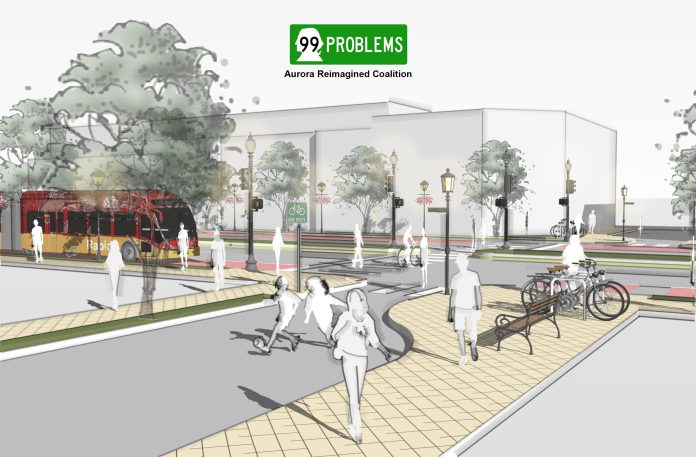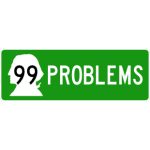After a summer of public outreach, SDOT is hearing recurring themes people want for the future of Aurora Avenue N.
Beginning in June, the public got to partake in guided discussion sessions with Seattle Department of Transportation (SDOT) for the transformative Aurora Avenue Project. The workshops were held in various locations within the sections of the road that are being studied. Ideas varied with one common theme in mind: People want to see a safer, more walkable, and vibrant Aurora Avenue N, one that works for everyone because right now it works for no one.
Aurora Reimagined Coalition is a grassroots organization of neighbors, businesses, community organizations and safe street advocates who focus on the improvements of the corridor. Their members attended the sessions and noticed recurring themes for how people want the road designed. These themes include:
- Running buses down the center
- Narrowing the road
- Doing both
Whichever options SDOT ultimately considers will make their way into proposed options after another round of public outreach in the fall. The city process for proposed improvements always requires a baseline option of no change, which will highlight the problematic nature of the status quo, so the first option is likely to contain only minimal changes like additional sidewalks, protected crossings, and street-end plazas that won’t change Aurora Avenue N’s essential nature.
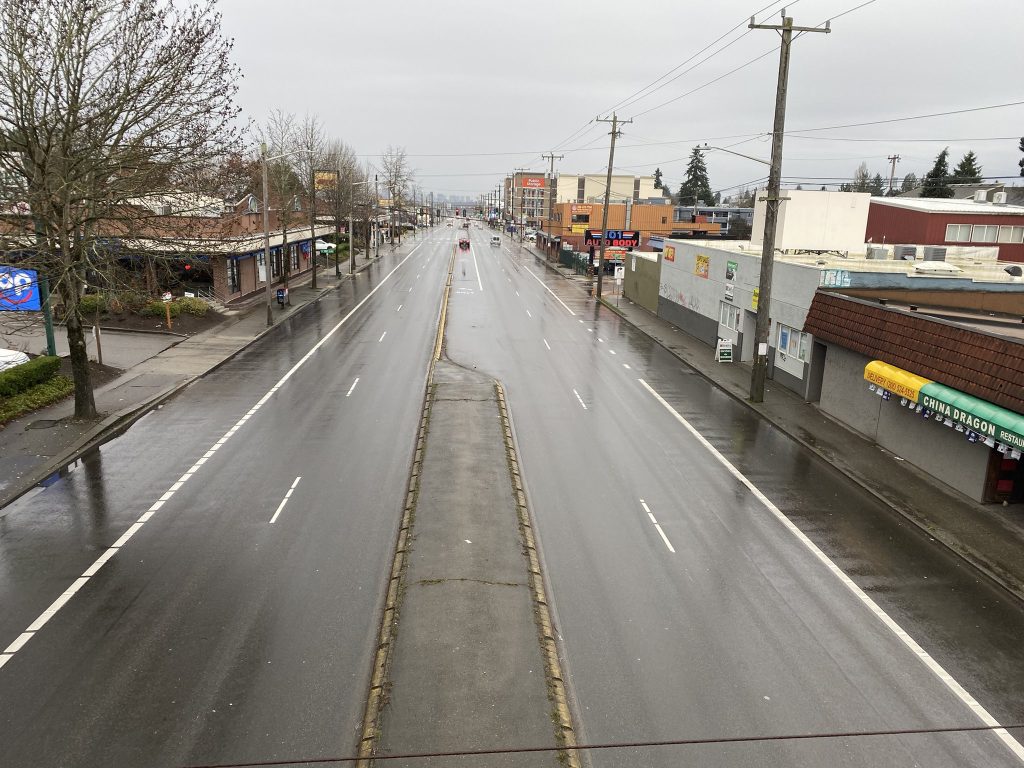
Currently, Aurora Avenue N is configured as a seven-lane road with buses running along the curbs, but feedback we heard suggests studying solutions that reposition the buses and asks whether the road really needs that much space dedicated to cars. With the Vision Zero campaign to end traffic deaths by 2030 endorsed as a guiding principle by both SDOT and the Washington State Department of Transportation (WSDOT), it would suggest the current configuration is at odds with their own outlined goals.
Center-Running Buses
Many attendees at the workshops suggested running the buses down the center of the highway in order to avoid traffic snags and delays from turning vehicles. This option was well received, and hopefully will be studied by SDOT and their consultants. Center-running buses provide the city the ability to smoothly transition the bus route to a light rail route when the fourth expansion for Sound Transit is voted on, passed, and Aurora gets a light rail line.
In addition, having the buses running down the center breaks the road’s scale in half. Right now, whether coming or going, on one end of your trip you will have to wait to cross seven lanes of traffic. Pedestrian leading intervals don’t add much to the clock and people with mobility issues are often left rushing to beat the countdown before the time expires. Putting buses in the middle means cutting crossing times in half, adding safety for drivers and bus riders without any real traffic disruption.
To enhance freight mobility, center-running buses give SDOT the option to turn bus only lanes into bus and freight lanes, putting heavier vehicles in the middle rather than having them share the curb and risk brushing up against pedestrians. This would be a safer solution for all and allows the median to turn into a freight load and unload space where we do not have bus stops, a current use seen today on Aurora.
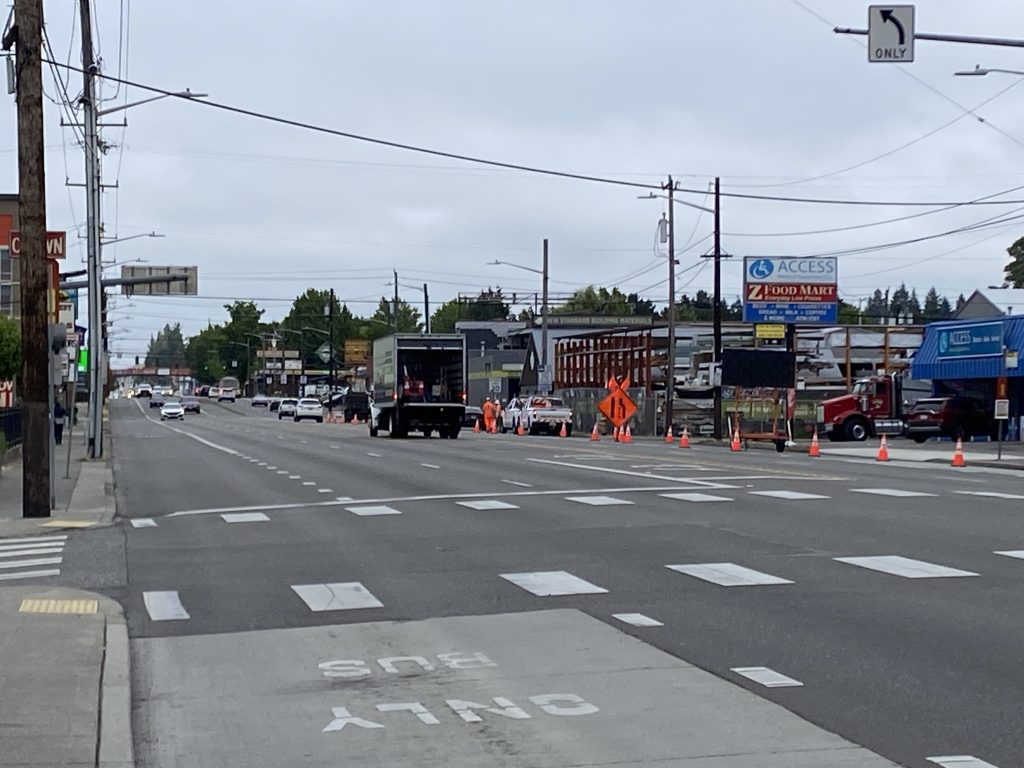
Center-running buses have been deployed around the country, including in Seattle. After a recent visit to San Francisco SDOT’s Director Greg Spotts tweeted a reply to Sound Transit CEO Julie Timm “I took a breathtaking complete streets pic” when he visited the Van Ness Avenue project which deployed center-running bus rapid transit as part of the new safety improvements. Overall, this strategy seems like a win no matter what lane count SDOT proceeds with.
Five Lanes Instead of Seven
Removing lanes was another popular suggestion at every workshop. Right now, this road is seven lanes wide and bisects or borders four of Seattle’s urban villages. These areas of Aurora Avenue N are targeted for growth with over 4,000 homes currently planned, permitted or under construction as of today.
Seattle’s Comprehensive Plan is leveraging options that will put another 80,000 homes within urban villages, and the likeliest of options leverage “corridors” for transit access for the remaining homes being planned. This means roads like Aurora Avenue N will carry the bulk of roughly 100,000 homes planned for the next 20 years. A seven-lane option will simply turn its back on the city’s growth strategy, doubling down on danger, pollution, and inequitable planning.
The census tracts along Aurora Avenue N are home to 12% of Seattle’s population already. These residents are provided the benefit of King County Metro’s top bus for ridership, the RapidRide E Line. Carrying 10,000 riders per day in 2021, when most of the city was working from home during the pandemic, this bus shows that ridership supports the route beyond downtown office commuting. People are using the E Line to get to parks, events, and handle their daily needs. After they exit the bus on Aurora Avenue N, they are left in a forgotten space, a street given over to cars, with narrow sidewalks, no bicycle infrastructure, and a noise level that is intolerable and worsens health outcomes for those who live along it.
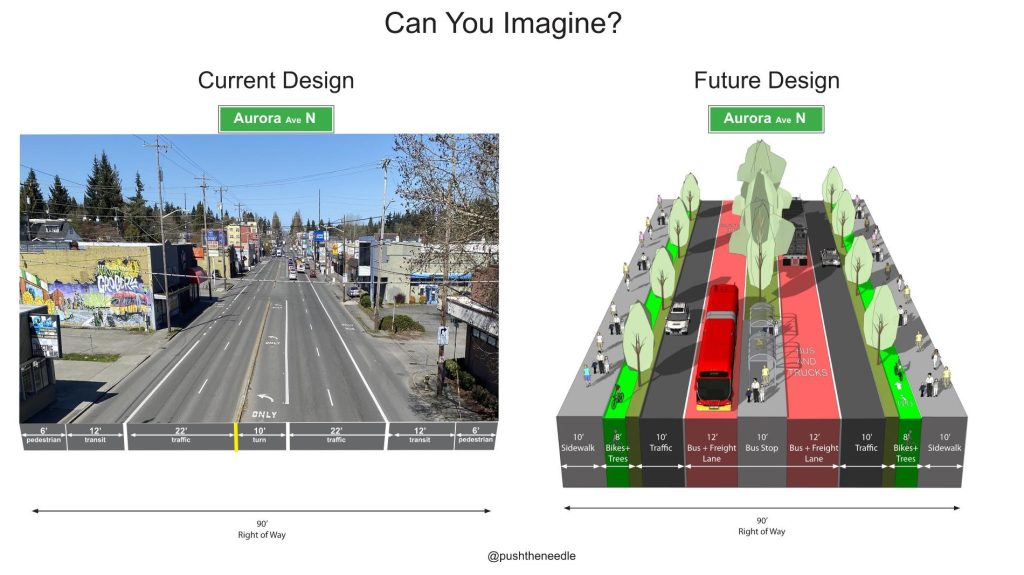
It would be a welcome change to prioritize mobility options other than cars, especially since the 2020 Census shows over 90% of Seattle’s households without a car live in multi-family housing, the very type of housing currently being built on and adjacent to Aurora Avenue N.
Narrowing motor vehicle space provides SDOT the opportunity of a lifetime. Imagine having tree-lined, protected bike lanes adjacent to wide sidewalks serving outdoor dining and comfortable storefronts along this densifying corridor. That won’t happen with a six or seven lane Aurora Avenue N. It’s clear that giving more than 20 feet of space back to the public traversing outside of a motor vehicle provides many options for safe and sustainable transportation in the future.
A Preferred Option
Center-running buses have been tried and proven successful around the country. Narrowing roads has a sustainable benefit and will make the road more livable for the new neighborhoods taking shape. The five-lane road with center-running buses seems to be the preferred alternative from the community, but to get there will require more study.
It will require bold leadership from the City and the State to transform Aurora Avenue N – bold leadership that looks beyond current or future vehicle counts and modeling to an Aurora Avenue N of the future. These workshops demonstrated both the community’s hunger and the community’s support for a transformation of Aurora Avenue N. With the leadership of both the City and State we can build a more livable, sustainable, multimodal Aurora Avenue N.
The Aurora Reimagined Coalition is a grassroots collective of community groups, safe street advocates, business owners, and active urban citizens who believe in sustainable solutions to improve our city and its roads. Learn more about the coalition at www.got99problems.org


